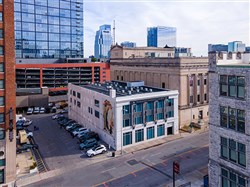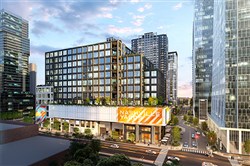VOL. 47 | NO. 17 | Friday, April 21, 2023
Today’s office has to be better than home
By Joe Morris
Three years ago, commercial office space of all size and amenity levels across Nashville and the Middle Tennessee market was, well, hot property. Then came COVID-19, working from home and the sluggish semi-return to the office. The resulting empty corridors and dusty desks have given no small amount of heartburn to the commercial real estate sector. But what to do?
Hot takes abounded:
• Would companies ditch their pricy downtown real estate or want smaller digs?
• Would they come back but demand remodeled floor plans to ease employee health and safety concerns?
• Would businesses stick with a hybrid model or ease their people back into a five-day workweek over time?
• Would an accounting outfit or law firm move ahead more quickly than a call center operation?
There’s remains no clear answer to any of those issues – in Nashville or any other urban core. Commercial property owners, managers and brokers are dealing with leasing and occupancy on a literal case-by-case basis, something not likely to change in the coming months or even years, says Bert Mathews, president of The Mathews Company and a partner with brokerage firm Colliers International Nashville.

Mathews
“The downtown office-space market is more than 15% vacant, and if you add sublease space on top of that you’ve got another 3% at least,” Mathews says. “It’s some of the highest vacancy rates we’ve seen in quite some time, and that’s related to a lot of people trying to figure out how they will ‘office’ over the next decade.”
Diana Johnson-O’Brien, research manager–Tennessee for CBRE, says the overall vacancy rate sits at 18.9% as of Q1 2023 – an increase of 9.8% compared to the fourth quarter of 2019.
High-end, smaller sites hot
Those vacancy figures aren’t spread evenly over the market, however. While some spots have been sitting empty for long periods, there’s no shortage of occupants vying for A++ high-end space, Mathews says.
“The very best buildings, both those that are new and those that have been around for a while, are seeing a lot of activity,” he says. “Spots like Broadwest, Nashville Yards, One 22 One, are seeing a lot of energy. That’s where the bulk of activity is right now because there are still tenants, like law firms, that want that very well-appointed, large space.”
Another positive sign is growth around smaller spaces, footprints that can be made ready and leased quickly. He points to the St. Cloud Corner building at Fifth and Church downtown as a site that is doing well filling spaces ranging from 1,500 to 3,000 square feet.
These days, most anything below 10,000 square feet is commonly referred to as ‘spec space,’ or ready to rent with a shorter lease (often as little as a three- to five-year terms) and/or reduced per-foot rate to get a lease inked, Mathews says, adding they are ideal for tenants who’ve got fewer than 50 people and need to reestablish or set up an office in weeks rather than months.
“People want to move quickly if they’ve decided to take or keep office space, and so we’re all trying to be quick, as well,” Mathews says. “A lot of those smaller spaces are being grabbed up by companies that have decided they need their people in the office three days a week or more, with perhaps Friday being a fully remote day.
“They need the spaces for people to occupy, and so they are looking at how they can accommodate the team they’re bringing back into a live space,” he continues.
“We can show them space that is fresh and ready so they can decide in an instant. They say, ‘we want it next month,’ we say ‘come on in.’”
There is also a massive amount of inventory coming online in the coming weeks and months. The number of cranes above construction sites also is heartening for the commercial real estate outlook here, industry insiders say.

O'Brien
“There are 2.8 million square feet of office space currently under construction in Nashville, and 70% of the under-construction product is taking shape in Nashville’s downtown corridor,” notes CBRE’s Johnson-O’Brien. “These projects will offer state-of-the-art amenities that will focus on placemaking and enhancing the tenant experience in the workplace.
“The hardest space to lease right now is second-generation buildings, specifically buildings that haven’t been recently renovated or improved,” adds Janelle Gallagher, first vice president of CBRE.

Gallagher
“In addition, buildings that aren’t close or walkable to amenities and experiences both inside the building and within the neighborhood are struggling. Some landlords with dated buildings have already improved their properties, and it’s helped create leasing velocity, especially in the suburbs. In some cases, improvements won’t help with leasing because of a building’s location, inefficiencies and lack of neighboring amenities.
“Most of the demand we’re seeing right now – especially in the urban part of Nashville – is for highly amenitized, new-construction product. Companies are creating office environments that make people want to come back to the office, as well as assist in talent recruitment,” Gallagher says.
Office amenities evolve
How will that office look? The “cube farm” model, which was often framed as an open, airy workspace by employers, is becoming a thing of the past. Employees are demanding a combination of open areas along with walled-off areas where they can have some privacy.
They also are extracting promises of more and better amenities, both within and around the space. It’s a very fluid area right now, but some changes appear to be hardening as well.
“It’s not so much about carpet and wallpaper anymore,” Mathews says. “It is often about building out more collaborative space, smaller conference rooms, newer furniture that creates private areas.
“That bullpen-type model is going away because if people come into an office, they don’t want to be right across from someone else, everyone wearing headphones,” he adds. “Their employers – and their landlords – are hearing that and making good choices when it comes to retrofitting current space and building out new ones.”
“Occupier demand has been largely centered around trophy (Class AA) assets due to the quality of amenities offered, desirable locations and the creation of an office environment where employees want to be,” adds Johnson-O’Brien.
“It’s all about reimagining the office environment and adapting to changes in how we all work in a post-pandemic era. The current under-construction pipeline is well-positioned to meet occupier appetite for highly amenitized, quality office space.”

Nashville’s office vacancy rate is high, but not on the high end as employers look to offer their workers the best space and amenities to keep them from wanting to retreat to their home offices.
-- Photograph ProvidedThat’s good, because commercial tenants and their employees also are paying a lot more attention to external space. Mathews says Nashville Yards as one example with a bustling and growing environment of retail, dining and green space around the office buildings.
The Gulch has built out with this model in mind, as well, enabling tenants to feel a part of the nearby tourism and recreation scene while they are at work.
Internally, he says, “what we’re seeing is that it is becoming all about light. People are wanting an office to be almost like a hotel space, so much more attention is being paid to the quality of light, to the space in which people are working.
“Firms that have found they have a whole subset of people who can work from home are keeping them there, but when they do bring them in for a meeting they want a gathering area that is much nicer than it might have been before.”
“If you’ve driven around Nashville lately, you’ve found that traffic is way up from where it was even six months ago,” Mathews says. “That tells me people are coming back to work. In some cases, they are being mandated or heavily incentivized to do so.
“Either way, that means a commute, which people have never liked, so the move is on to make sure they are rewarded for being in person, for having that contact with others. People want their space to have a lot of energy.”
Shorter, better leases
Along with shorter leases, a more polished buildout also shifts some risks back to owners. Even so, Mathews says, the risk will likely work out because the landlords are filling the space now, and in so doing are learning as they go about what newer tenants want and need.
That will set them up to compete more effectively when, in a still-growing urban core like Nashville, newer properties continue to frequently come onto the market.
“Every company is unique,” Mathews says. “A law firm or other large business firm may want people in person, whereas something more like a call center operation has found they can work quite well remotely.

Office space in Nashville Yards delivers walkable access to restaurants, shopping and green spaces.
-- Photograph Provided“What that means for landlords is figuring out not only how to reconfigure space, but also who to be marketing to find the right tenants.”
‘Flight to quality’
This move toward higher-end facilities or requests for significant upgrades are part of the ‘flight to quality’ trend. As Mathews defines it, this is “interest in the newest buildings that have the most bells and whistles. They have elevator systems that operate in a certain way or an HVAC system that scrubs the air more efficiently.
“It can be as simple as finishing touches that are truly exceptional or building services and amenities around conference centers, exercise and food that are top-notch,” he adds.
“Flight-to-quality, or flight-to-experience as some might call it, is the concept of companies seeking out premier office space in a prime location that offers top-tier amenities and an enhanced experience for tenants,” adds Johnson-O’Brien. “While this concept is not necessarily new, it gained momentum in the wake of the pandemic as companies began reevaluating their office space needs and strategizing their return-to-work policies for their employees.
“Building amenities are a key focus, as well as enhanced technology in buildings, wellness solutions, incorporation of collaborative and individualized breakout rooms, outdoor space, building events, good food and beverage options, and an even greater emphasis on Environmental, Social and Governance (ESG) features,” she continues.
“It’s all about place-making and bringing convenience and comfort to the workplace to attract companies to your building that, in turn, are seeking to create an experience for their employees to incentivize them to want to come into the office. And many companies are turning to the flight-to-quality trend as a strategic solution to elevate workplace culture and increase in-person head counts.”
“The trend has really become more of a “flight to experience,” meaning a building has thoughtful on-site amenities dedicated to tenants, as well as vibrancy in the walkable immediate area with restaurants, amenity retail, green space, hotels and multifamily,” Gallagher concludes. “Tenants engaging in a flight to quality are looking for the newest and most innovative workplace to create an environment where employees want to work and that fosters collaboration and company culture. As a result, we’re seeing the flight to quality inform and guide building design, as well as the ways tenants are building out their interior spaces.”
It’s a concept with newer space in mind, but older buildings also can compete, to a degree. They can upgrade as much as possible, and also pivot completely and be rehabbed into a completely new use like residential spaces, filling a housing need in the center city while also providing a possibly better ROI for owners.
“Some spaces are being converted to residences in much the same way as the spec suites,” Mathews says. “Property owners have found that converting 5,000 square feet at a time is difficult in a big building, so they’re converting the whole space to an entirely new use, and then carving up the space into different footprints.
“They’re doing everything they can to put the sizzle back in a building that’ll never be A++ but with some work can become A-, so it has a lot of appeal nonetheless.”
Near-term still anyone’s guess
Nobody wants to be on record with an absolute prediction of how the commercial real estate market is going to shake out over the next year or so. That said, there are a few elements to the market that can be noted, even in a period of great flux.
“The solution is not offering the cheapest rent,” Mathews says. “That’s not winning in this marketplace. It’s delivering wonderful spaces that people want to be in, perhaps with a shorter lease, which moves the risk back some toward landlords but makes the space an easier sell to potential tenants.”
Nashville also will still benefit from its continued desirability as a market, Gallagher says, and will still see leasing velocity through 2023 – although it won’t be as active as pre-COVID years.
“Once the interest-rate environment and the extent of the forecasted economic headwinds become clearer, we believe demand and activity will pick up in a big way in 2024,” she says.
“A year from now we’ll have a much better idea of what the work environment is going to look like, and that will color the commercial real estate market outlook,” Mathews says. “Before COVID sent everyone home we had a tight job market, and we still have that, so the scale tipped in the employees’ direction.
“It’ll swing back toward the employer, and they’ll perhaps be less likely to offer quite as many amenities. Even so, businesses are now operating in a very different way, and that will continue. We’re in a dramatic discovery period right now, and there’s not going to be one answer for everybody.”